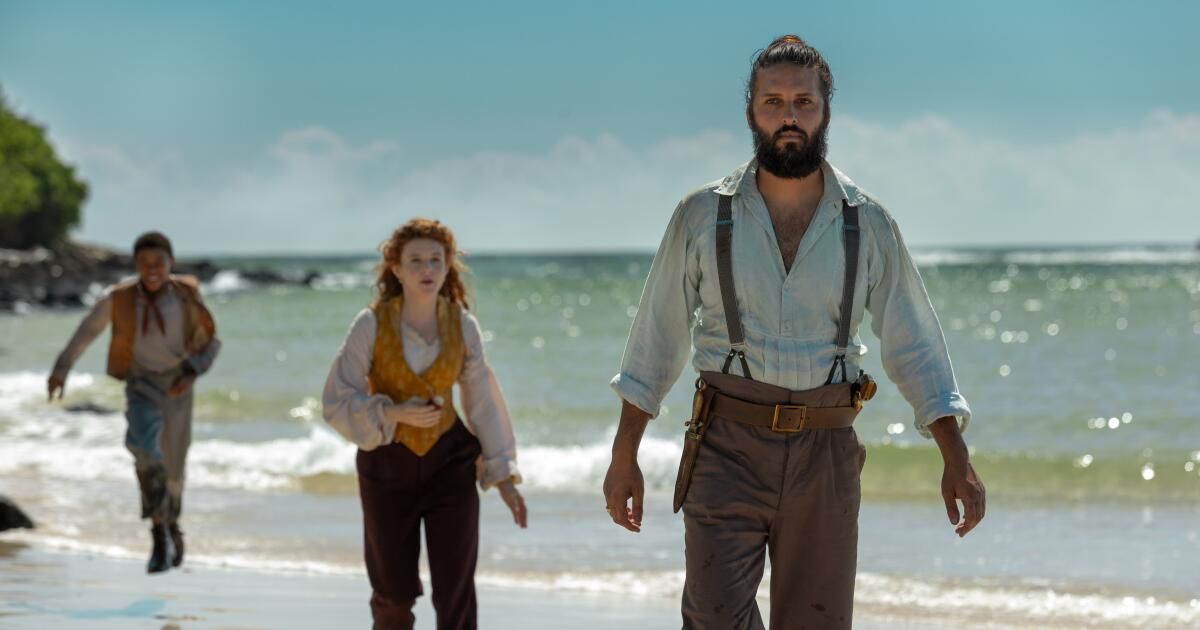Certain elements of Jules Verne's 1870 novel “Twenty Thousand Leagues Under The Sea” have become a television series, “Nautilus”, which premiered on Sunday in AMC, which picked up the program after Disney+, which ordered and completed it, dropped it. Created by James Dormer, it is not an adaptation but a prequel, or a history of origin, as comics children like to say, in which Nemo, still does not captain, sets in his submarine for the first time.
Verne's imaginative fiction has inspired more and less faithful screen adaptations since the days of silent films. (Georges Méliès 1902 “A Trip to The Moon”, partially based on Verne's 1865 “From The Earth to the Moon”, the first science fiction film is counted). For a few years of Midentury, perhaps inspired by the success of the “20,000 leagues” of Disney “, a cotteges movie”, and continues to explode in its thematic parks, and Mike Todd's “Around the World in 80 days,” The days, “the days”, “It was a movie,” it was almost a movie. “To the center of the earth,” “” “” ” Five weeks in a balloon. ” I grew up watching these films returning to television; They are cheesy and fun, as are “nautilus”, with more elegant effects, anti -corporated feelings and people of color.
We have seen Nemo played by James Mason, Michael Caine, Patrick Stewart, Ben Cross and Robert Ryan, but in “The Mysteros Island”, the species of sequel to Verne of “Twenty Mil Legues”, identified Nemo as an Indian prince, as shown here, performed by Shazad Latif, deposed by an imperial power, his wife and children killed. The character is usually a little crazy, and this Nemo, Pightard, Mandón, is not totally an exception, although he is also a young, burning hero and with a more sin man than sin. We know him as a prisoner of the British mercantile company of Eastern India, “the most powerful corporation that has existed, more powerful than any country”, which is building the Nautilus in India with the work of slaves, in search, says the director of the Villano Crawley company (Damien Garvey), of “learning and exploiting the Chinese market.” I am not sure how a submarine should do that, but, huh, it is a reason.
Nemo has been collaborating with the inventor of the submarine, Gustave Benoit (Thierry Frémont), who had accepted the money of the corporation under the promise that it would be used for exploration: scientists can be so dense. Nemo, whom the teacher accredits as the mind behind the ship's engine, has its own use for Nautilus and executes a hurried escape with a middle random team of internal companions in a skillfully staging sequence that takes a lot of “Indiana Jones”, an inspiring well to which the series returns.
And we are out. On the agenda: escape, revenge and find the treasure buried to finance revenge.
They join the Nautilus Loti (Céline Menville) and Humility (Georgia Flood) crew.
(Vince Valitutti / Disney+)
When Nautilus, just on the way, paralyzes the ship in which they are traveling, under the impression that the subtitm is under attack, the crew joins, without voluntarily, by humility Lucas (Georgia Flood), a British socialite with scientific mentality with super engineering skills, which is being packed to combine to marry the Lord Pitt (Cameron Cameron). She is accompanied by a chaperona/Guardian, Loti (Céline Menville), a Frenchman who has a bad way with a dagger and boy boy Blaster (Kayden Price). And a small dog too. The sparks will obviously fly between Nemo and humility, bad sparks, then good sparks, as in an Astaire and Rogers movie, and there are real sparks of a bad electrical connection, humility works how to fix.
In addition to Benoit, Humility and Loti, a great partner named Jiacomo (Andrew Shaw), who comes from nobody knows where and speaks a language that nobody understands, and a British Stowaway, Nautilus's crew are all people of color: southern Asia, Asia, the Middle East, African or Pacific. Few really develop as characters, but the actors give them life, and the support players carry the comedy, of which there is a lot. An episode invests the old and tired scenario in which white explorers are threatened with death by dark skin natives; Here, the captors are Nordic warriors. The show is anti -colonial and anti -imperialist in a way that “Star Wars” taught the public to recognize, if not necessarily recognize in the world that surrounds them, and anti -capitalist in a way that movies have always been. (The final episode, which has a financial issue, is titled “Too great to fail.” It is quite absurd).
Sometimes it can be slow, which is not inappropriate for a show that takes place largely underwater. But that its structure is essentially episodic that maintains colorful and interesting “nautilus” that if it simply stretched on the shelf of a long arch in its 10 episodes. It is very similar to a (preventive) “Star Trek”, which is, after all, a naval metaphor, its crew sailing through a hostile environment that meets a variety of monsters and cultures week by week; In fact, there are some similar stories: the crew infected by a mysterious sporada, the ship threatened by small beasts and giant monsters, meets a tin dictator and semimitological figures, everything that was persecuted by a prey klingon bird, sorry, a giant metal war ship.
The greatest successes of the underwater adventure (some of Verne's novel) are covered: volcanoes, giant squid, giant eel, engine problems, running out of air and the ruins of a lost civilization (is Atlantis? Benoit hopes). Less common: a Cricket game on ice. In addition to a whale sheath outside the window (and, later, a whale rescue), does not spend much time to the wonders of the sea: the budget of special effects, which in other aspects has been generously dedicated, apparently there was no room left for fish schools. But these submarines have other things in their minds.
The chances of a second season, says my murky glass ball, are limited, so you may have to accommodate some minor cliffs if you decide to look. I did not regret the time I spent here, even though I sometimes had no idea what was happening or I found it ridiculous when I did, since there was generally some stimulating activity or a little landscapes or details of Steampunk's design to enjoy. I mean, I saw an episode of “Voyage to the Bottom of the Sea” recently, a series of submarines of the 1960s, in which the guest star John Cassavetes created a superbomba that could destroy the three quarters of the world, and almost nothing made any sense, including the presence of John Cassavetes. “Nautilus” is really good.












